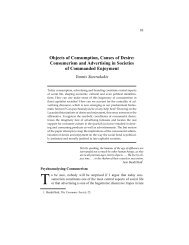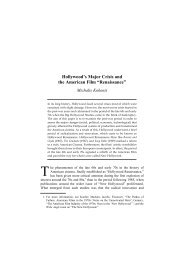19 International Symposium on Theoretical and Applied Linguistics ...
19 International Symposium on Theoretical and Applied Linguistics ...
19 International Symposium on Theoretical and Applied Linguistics ...
Create successful ePaper yourself
Turn your PDF publications into a flip-book with our unique Google optimized e-Paper software.
G E N E R A L S E S S I O N<br />
being ‘c<strong>on</strong>tinually shaped <strong>and</strong> reshaped through interacti<strong>on</strong>s with others <strong>and</strong> involvement in social <strong>and</strong><br />
cultural activities’ (Wetherell & Maybin, <str<strong>on</strong>g>19</str<strong>on</strong>g>96, p.220).<br />
Furthermore, not <strong>on</strong>ly is this self diverse <strong>and</strong> ever-changing, narratives in which these selves occur<br />
are also ‘versi<strong>on</strong>s of reality’ (Ochs & Capps, <str<strong>on</strong>g>19</str<strong>on</strong>g>96, p.21) that are closely linked to their c<strong>on</strong>texts. This<br />
relati<strong>on</strong> is extremely intricate, since although the time of the story that is narrated is clearly situated in<br />
the past, the time of narrating is obviously in the present <strong>and</strong> therefore also str<strong>on</strong>gly linked to that<br />
specific c<strong>on</strong>temporary c<strong>on</strong>text. Typical elements that can influence life stories are social <strong>and</strong> political<br />
changes that have taken place between the time of the narrated <strong>and</strong> the present.<br />
In this presentati<strong>on</strong>, I discuss a narrative that focuses <strong>on</strong> the Sec<strong>on</strong>d World War. Since there is a<br />
time span of approximately sixty years between the time of the narrated <strong>and</strong> the present, it is fairly<br />
logical that the narrator has reflected <strong>on</strong> his past <strong>and</strong> that this mental process influences the way he<br />
c<strong>on</strong>structs his identity in his story. As Linde observes, such a time lapse ‘creates the occasi<strong>on</strong> for self<br />
regard <strong>and</strong> editing' (Linde, <str<strong>on</strong>g>19</str<strong>on</strong>g>93, p. 105). As <strong>on</strong>e of the most important functi<strong>on</strong>s of this reflexivity, she<br />
discerns the establishment of ‘the moral value of the self’. People […] want a good self, <strong>and</strong> a self that<br />
is perceived as good by others.’ (Linde, <str<strong>on</strong>g>19</str<strong>on</strong>g>93, p. 122).<br />
Taking all these elements into account, I propose to integrate another element as an additi<strong>on</strong>al<br />
dimensi<strong>on</strong> in the analysis, namely the interview style. This is not <strong>on</strong>ly an important aspect of the<br />
c<strong>on</strong>temporary c<strong>on</strong>text, but it focuses also <strong>on</strong> the fact that narratives, <strong>and</strong> c<strong>on</strong>sequently the identities<br />
within them, are being co-c<strong>on</strong>structed. As Holstein <strong>and</strong> Gubrium observed, interviewers are always<br />
involved in the c<strong>on</strong>structi<strong>on</strong> of meaning that is generated in interviews. Because ‘both parties to the<br />
interview are necessarily <strong>and</strong> unavoidably active’, meaning is ‘actively <strong>and</strong> communicatively<br />
assembled in the interview encounter’ (2003, p. 68). By analysing the way the interviewee positi<strong>on</strong>s<br />
himself in relati<strong>on</strong> the questi<strong>on</strong>s of the interviewer, the influence of the interview style <strong>on</strong> the<br />
c<strong>on</strong>structi<strong>on</strong> of identity is being scrutinized.<br />
References<br />
Holstein, J.A. & Gubrium, J.F. 2006. Postmodern interviewing. Thous<strong>and</strong> Oaks, CA: Sage.<br />
Linde, C. (<str<strong>on</strong>g>19</str<strong>on</strong>g>93). Life Stories: The Creati<strong>on</strong> of Coherence. Oxford: Oxford University Press.<br />
Ochs, E. & Capps, L. <str<strong>on</strong>g>19</str<strong>on</strong>g>96. Narrating the self. Annual Review of Anthropology, 25, <str<strong>on</strong>g>19</str<strong>on</strong>g>-43.<br />
Wetherell, M. & Maybin, J. <str<strong>on</strong>g>19</str<strong>on</strong>g>96. The distributed self: a social c<strong>on</strong>structi<strong>on</strong>ist perspective. In R. Stevens (Ed.),<br />
Underst<strong>and</strong>ing the self (pp. 2<str<strong>on</strong>g>19</str<strong>on</strong>g>-279). L<strong>on</strong>d<strong>on</strong>: Sage.<br />
Pr<strong>on</strong>ominal choice <strong>and</strong> identity in the academic writing of Italian students of English<br />
Carla Vergaro<br />
University of Perugia<br />
vergaro@unipg.it<br />
This paper reports a study <strong>on</strong> the expressi<strong>on</strong> of identity in the academic writing of Italian students of<br />
English. That academic writing c<strong>on</strong>veys a representati<strong>on</strong> of the self together with c<strong>on</strong>tent is something<br />
that research has emphasized. Indeed, the issue of authorial stance, namely how much writers feel<br />
themselves to be not just writers but also authors with the authority to say something, has attracted<br />
<strong>and</strong> has been the topic of much research. A rather obvious way of claiming authorial presence is to<br />
use first pers<strong>on</strong> reference <strong>and</strong> the corresp<strong>on</strong>ding determiners. However, not <strong>on</strong>ly is the I emerging<br />
from the text by its very nature plural, but different genres are associated with differing degrees of Iism,<br />
<strong>and</strong> these expectati<strong>on</strong>s <strong>and</strong> c<strong>on</strong>venti<strong>on</strong>s vary from culture to culture <strong>and</strong> from period to period. In<br />
the c<strong>on</strong>text of academic writing, the task of acquiring genre c<strong>on</strong>venti<strong>on</strong>s that require authors to<br />
positi<strong>on</strong> themselves in the text in a certain way, is particularly difficult for L2 students because, being<br />
at the same time under the influence of their own culture, both genre <strong>and</strong> cultural c<strong>on</strong>venti<strong>on</strong>s might<br />
be operating. In this paper I explore the expressi<strong>on</strong> of identity in the academic writing of Italian<br />
students of English by focusing <strong>on</strong> the use of first pers<strong>on</strong> pr<strong>on</strong>ouns I, we, me, <strong>and</strong> us <strong>and</strong> their<br />
respective determiners. Indeed, although the issue of identity in writing has been the focus of much<br />
research in recent years, less attenti<strong>on</strong> has been paid to students as authors, much more so to EFL<br />
Italian students. The study – based <strong>on</strong> an analysis of a corpus of 30 essays, each of about 4,000<br />
words in length – shows that cultural <strong>and</strong> genre c<strong>on</strong>venti<strong>on</strong>s are intertwined in a complex way in a<br />
heteroglossic space in which a rec<strong>on</strong>structi<strong>on</strong> of the self takes place. This process is fruitfully<br />
explained by recurring to the heuristic of intercultural – not c<strong>on</strong>trastive – rhetoric <strong>and</strong> to the post-<br />
Kantian philosophy noti<strong>on</strong> of ‘thirding’.<br />
<str<strong>on</strong>g>19</str<strong>on</strong>g> th ISTAL 60






